
How Do Personalized Game Features Drive Player Engagement?
#
Key Takeaways
- Adaptive gaming systems create unique experiences tailored to individual player preferences
- Real-time data analysis enables dynamic difficulty adjustment and content personalization
- Personalized rewards and progression paths increase player retention and satisfaction
Understanding Game Personalization
Modern games leverage sophisticated algorithms and player behavior analysis to deliver customized gaming experiences. Unlike traditional one-size-fits-all approaches, today’s games adapt in real-time to each player’s skill level, preferences, and playing style.
Core Personalization Features
- Dynamic difficulty adjustment
- Customized reward systems
- Adaptive storylines and missions
- Personalized in-game recommendations
- Individual progression paths
How Personalization Impacts Engagement
Personalized gaming features create deeper player connections through:
- Tailored challenge levels that maintain optimal flow
- Rewards that align with individual player motivations
- Content recommendations based on past gameplay patterns
- Adaptive narratives that respond to player choices
Real-Time Adaptation Mechanics
Game systems continuously monitor player performance metrics, including:
- Success and failure rates
- Time spent on different activities
- Resource management patterns
- Social interaction preferences
- Achievement progression
Benefits of Personalized Gaming
- Increased player retention
- Higher satisfaction levels
- More meaningful progression
- Reduced frustration and churn
- Enhanced learning curves
- Stronger community engagement
Future Developments
Advanced AI and machine learning continue to evolve gaming personalization through:
- Predictive player behavior modeling
- Enhanced emotional response tracking
- More sophisticated adaptation algorithms
- Deeper social integration features
Dynamic Difficulty Adjustments
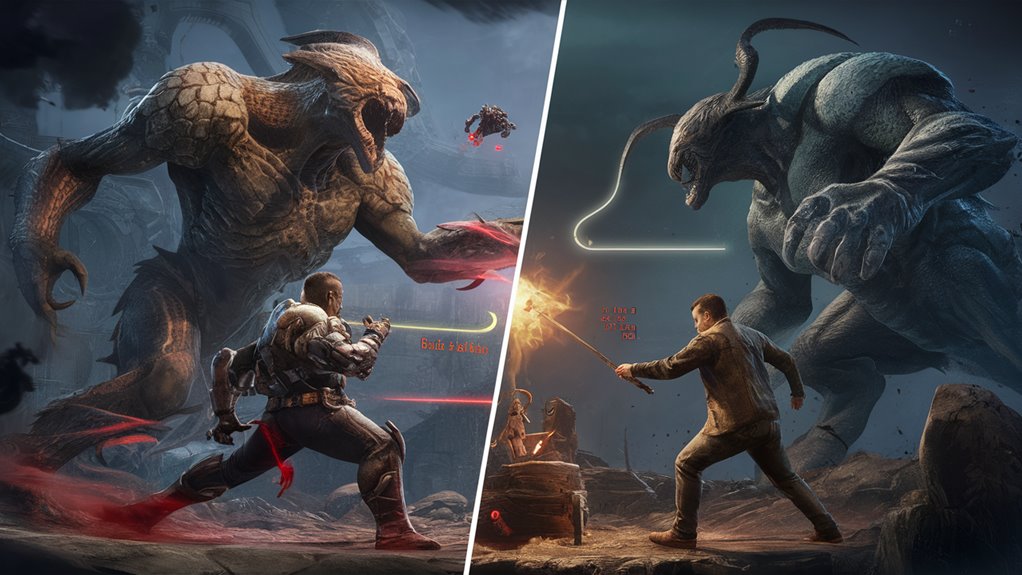
How Does Dynamic Difficulty Adjustment Make Games More Engaging?
Key Takeaways
- DDA automatically adjusts game difficulty based on player performance metrics
- Real-time monitoring of player data enables natural, unobtrusive difficulty changes
- Invisible adjustments maintain player engagement while preserving achievement satisfaction
Understanding Dynamic Difficulty Adjustment
Dynamic difficulty adjustment (DDA) transforms gaming experiences by automatically modifying challenge levels based on individual player performance and skill.
When games implement DDA effectively, players maintain an optimal balance between feeling frustrated and bored. For instance, during challenging boss battles, the system might subtly reduce enemy health or simplify attack patterns.
Alternatively, when players demonstrate mastery, the game increases puzzle complexity or enhances enemy AI behavior.
How DDA Systems Track Player Performance
Successful DDA systems leverage multiple data points to create personalized experiences:
- Reaction times
- Accuracy rates
- Completion speeds
- Player death frequency
- Resource management effectiveness
By monitoring these metrics in real-time, games make micro-adjustments that feel natural and maintain player engagement.
This data-driven approach helps maintain the critical “flow state” where players feel appropriately challenged yet capable of success.
The Art of Invisible Difficulty Management
The most effective DDA systems operate invisibly, making adjustments that players rarely notice.
This behind-the-scenes approach:
- Preserves the sense of genuine achievement
- Maintains consistent engagement levels
- Adapts without breaking immersion
- Supports natural game progression
When implemented correctly, these subtle modifications keep players invested while ensuring their accomplishments feel earned rather than artificially granted.
Player-Driven Narrative Paths

How Do Player-Driven Narratives Enhance Gaming Engagement?
Key Takeaways
- Player choices create unique storytelling experiences that increase emotional investment
- Meaningful consequences drive higher replay value and engagement
- Clear feedback systems help players track their narrative impact
- Branching storylines enable personalized gameplay journeys
Player-driven narratives have emerged as a crucial engagement tool in modern gaming, allowing players to shape their unique stories through meaningful choices and consequences.
Games like Mass Effect and The Witcher 3 showcase how branching narratives create personalized experiences that keep players invested for longer periods.
Creating Meaningful Consequences
The effectiveness of player-driven narratives depends on implementing consequences that matter throughout the gameplay experience:
- Immediate outcome changes
- Long-term story developments
- NPC relationship shifts
- Quest line availability
- Multiple ending possibilities
Essential Elements for Success
Three core components ensure effective player-driven storytelling:
- Clear Choice Presentation
- Transparent decision points
- Understandable options
- Well-defined stakes
- Impact Visualization
- Relationship meters
- Faction standings
- Story path indicators
- Consistent Story Branching
- Interconnected narrative threads
- Logical consequence chains
- Multiple valid story paths
Implementing these elements helps players understand how their decisions actively shape the game world, encouraging multiple playthroughs to explore different narrative possibilities and maintaining long-term engagement with the content.
Customizable Character Development Systems
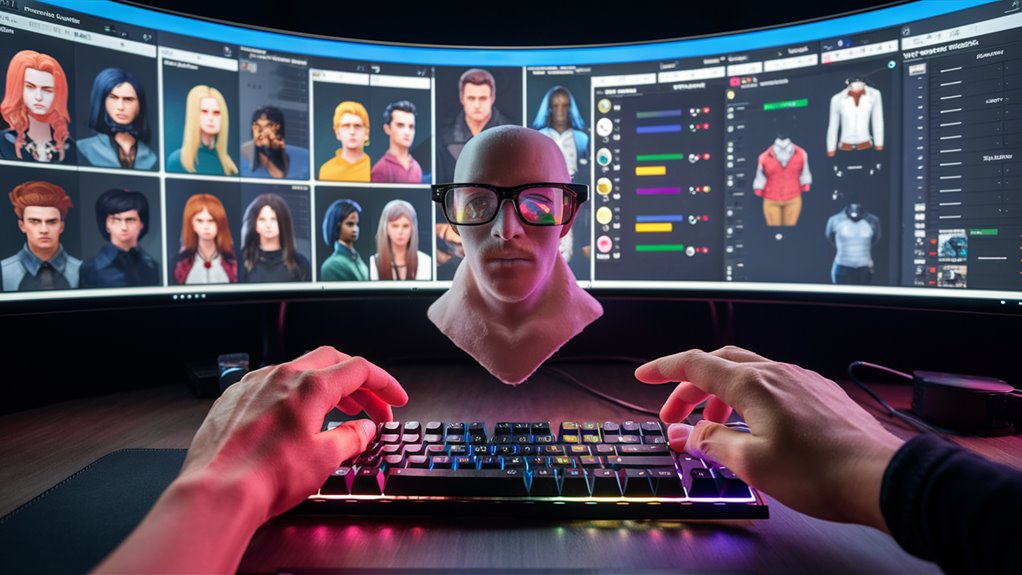
How Do Customizable Character Development Systems Work?
Key Takeaways
- Character development systems give players direct control over their avatar’s progression
- Flexible progression paths increase replay value and player engagement
- Balanced systems combine accessible mechanics with meaningful depth
- Achievement-based unlocks create stronger player-character connections
Understanding Character Development Mechanics
Customizable character development systems empower players to shape their avatar’s growth through skill points, ability choices, and attribute selection.
These systems create a direct link between player decisions and in-game performance, fostering deeper engagement with the gameplay experience.
Building Flexible Progression Paths
Modern character development systems thrive on flexibility. Players benefit from:
- Respec options for build experimentation
- Multiple specialization paths
- Skill trees and talent systems
- Complex character building mechanics
Games like Path of Exile demonstrate how intricate character building becomes a compelling game mechanic itself, driving player engagement through meaningful choices.
Balancing Accessibility and Depth
Effective character progression systems require:
- Clear feedback on how choices affect gameplay
- Sufficient complexity for experimentation
- Intuitive mechanics for new players
- Depth for experienced players
Achievement-Based Development
Linking character progression to gameplay milestones creates more engaging development paths:
- Specific challenges unlock new abilities
- Achievement-based rewards feel more meaningful
- Players connect more deeply with character growth
- Gameplay accomplishments drive character evolution
This approach ensures players feel a stronger connection to their character’s journey while maintaining engagement through tangible progression goals.
Adaptive AI Behavior
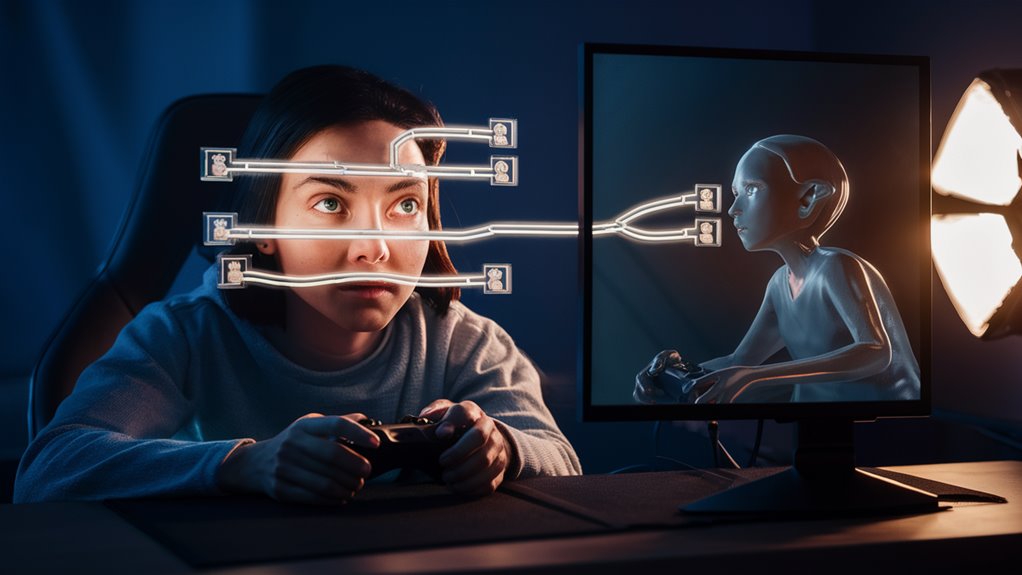
How Does Adaptive AI Transform Gaming Experience?
Key Takeaways:
- Adaptive AI systems dynamically adjust enemy behavior based on player performance
- Dynamic difficulty balancing creates personalized challenge levels
- Subtle implementation ensures natural-feeling gameplay adjustments
- Real-time learning from player actions enhances engagement
Understanding Adaptive AI in Games
Adaptive AI systems enhance gaming experiences by continuously analyzing player behavior and adjusting enemy responses in real-time.
When players consistently employ specific strategies, like stealth tactics, the AI responds by implementing countermeasures such as repositioning guards or modifying patrol patterns.
Dynamic Difficulty Balancing
The strength of adaptive AI lies in its ability to maintain optimal challenge levels through dynamic difficulty balancing.
During challenging segments, the system automatically reduces enemy aggression or accuracy. Conversely, when players demonstrate mastery, the AI increases difficulty parameters.
Games like Left 4 Dead showcase this through their AI Director system, which adjusts enemy spawns and resource placement based on team performance.
Implementing Effective Adaptive AI
Successful adaptive AI requires subtle implementation that avoids obvious difficulty manipulation. The key aspects include:
- Gradual parameter adjustments
- Natural-feeling responses to player actions
- Personalized difficulty scaling
- Seamless integration with gameplay mechanics
This approach creates an engaging experience that keeps players within their optimal challenge zone while maintaining immersion.
Personal Achievement Tracking

How Can Achievement Tracking Enhance Your Gaming Experience?
Key Takeaways:
- Achievement tracking provides measurable feedback on player progress
- Visual progression systems boost player engagement and motivation
- Personalized goal-setting creates meaningful gaming experiences
- Data-driven insights help players improve their performance
Understanding Achievement Tracking Systems
Achievement tracking combines statistics monitoring and milestone recognition to help you measure progress in your gaming journey.
This system creates a feedback loop that keeps you engaged while providing clear evidence of your development over time.
Core Components of Effective Achievement Systems
- Progression Markers
- Win rates and completion times
- Skill improvement metrics
- Performance benchmarks
- Achievement milestones
- Visual Growth Representation
- Achievement trees
- Milestone badges
- Progress bars
- Performance graphs
- Personalized Goal Framework
- Custom challenge settings
- Skill-specific targets
- Speed run objectives
- Rare accomplishment tracking
Data Visualization and Performance Analytics
Track your gaming progress through:
- Personal best records
- Historical performance trends
- Comparative analytics
- Growth indicators
Customizable Goal Setting
Your achievement journey can be tailored through:
- Ability mastery tracking
- Speed run achievements
- Rare accomplishment hunting
- Custom milestone creation
This personalized approach ensures that your tracking experience remains relevant and motivating, regardless of your gaming preferences or skill level.
Tailored In-Game Recommendations

How Do In-Game Recommendations Enhance Your Gaming Experience?
## Key Takeaways
- Smart recommendation systems analyze player behavior to suggest personalized content
- Machine learning algorithms improve suggestion accuracy over time
- Personalized recommendations lead to higher player retention and engagement
- Seamless integration maintains natural gameplay flow
Understanding Personalized Game Recommendations
In-game recommendation systems transform your gaming experience by analyzing your unique play style, preferences, and historical choices.
These intelligent systems track your achievements and deliver tailored content suggestions that match your demonstrated abilities and interests.
After completing challenging quests, you’ll receive 사용자 생성 리뷰 확인 suggestions for similar adventures aligned with your skill level and story preferences.
Real-World Applications of Gaming Recommendations
Consider these practical examples of personalized recommendations in action:
- Crafting enthusiasts receive suggestions for:
- New recipe discoveries
- Rare material locations
- Crafting-focused quest lines
- PvP-focused players get recommendations for:
- Competitive events
- Tournament opportunities
- Advanced combat techniques
The Technology Behind Smart Recommendations
Modern recommendation systems employ sophisticated machine learning algorithms that continuously refine their accuracy by monitoring:
- Activity completion rates
- Time investment in different gameplay elements
- Social interaction patterns
- Player achievement tracking
These systems contribute to increased player retention by minimizing time spent searching for content and maximizing engagement with personally relevant activities.
The recommendations integrate smoothly into gameplay, enhancing rather than disrupting the player’s immersion in the gaming world.
Social Connection Features
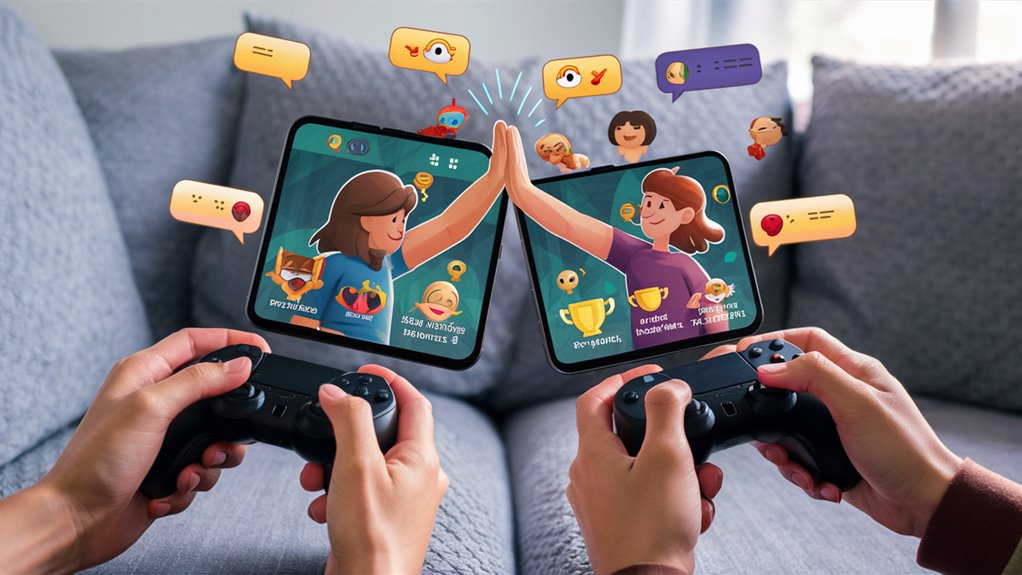
How Can Social Connection Features Transform Gaming Communities?
Key Takeaways
- Social features like friend lists and guilds create lasting player relationships
- Real-time communication tools enable authentic player expression
- Collaborative systems boost engagement and player retention
- Smart matchmaking enhances player satisfaction and community growth
Social connection features transform gaming experiences by combining community building tools with interactive engagement systems.
These features create vibrant digital spaces where players develop meaningful relationships and shared experiences.
Essential Communication Tools
Real-time chat systems, voice communication, and personalized emotes serve as the foundation for player interaction. These tools enable:
- Instant messaging for quick coordination
- Voice chat for immersive teamplay
- Custom emotes for personality expression
- Screenshot sharing for memorable moments
Community Building Systems
Player communities thrive through structured social systems:
- Friend lists for maintaining connections
- Guild systems for organized group play
- Team-based activities for collaborative goals
- Achievement sharing for community celebration
Advanced Social Features
Deeper social integration comes through specialized systems:
- Mentor-mentee programs connecting veterans with newcomers
- Custom profile pages showcasing achievements
- Collaborative events requiring diverse skillsets
- Cross-platform functionality for broader connection
Smart Matchmaking Implementation
Effective player matching considers multiple factors:
- Skill level compatibility
- Similar play styles
- Shared interests
- Time zone alignment
- Language preferences
These social features, when properly implemented, create a sustainable ecosystem that encourages long-term player engagement and community growth.
Learning-Based Tutorial Systems

How Do Modern Gaming Tutorial Systems Use Adaptive Learning?
Key Takeaways
- Adaptive learning algorithms personalize gaming tutorials based on player performance
- Tutorial systems combine contextual hints, skill progression, and real-time feedback
- AI-driven systems adapt to different learning styles and track long-term progress
Understanding Adaptive Tutorial Systems
Modern gaming tutorials leverage adaptive learning algorithms to track gameplay patterns and customize instruction delivery.
These systems analyze player performance in real-time, identifying areas where users struggle and providing targeted guidance without disrupting gameplay flow.
Components of Effective Learning-Based Tutorials
The most successful tutorial systems integrate three core elements:
- Contextual hints that appear during relevant gameplay moments
- Skill-based progression tracking
- Real-time performance feedback
For example, when players learn combat mechanics, the system identifies their preferred fighting style and tailors examples accordingly, introducing advanced techniques only after basic mastery is demonstrated.
Personalized Learning Approaches
Different players learn through various methods:
- Visual demonstrations
- Hands-on practice
- Step-by-step instructions
AI-powered tutorials detect individual learning preferences and modify their teaching approach accordingly.
The system maintains a progress log to:
- Track skill development over time
- Reintroduce previously learned concepts
- Suggest new strategies based on evolving gameplay patterns
These adaptive systems ensure each player receives personalized instruction that matches their learning style and skill level, maximizing engagement and knowledge retention.
Individual Resource Management
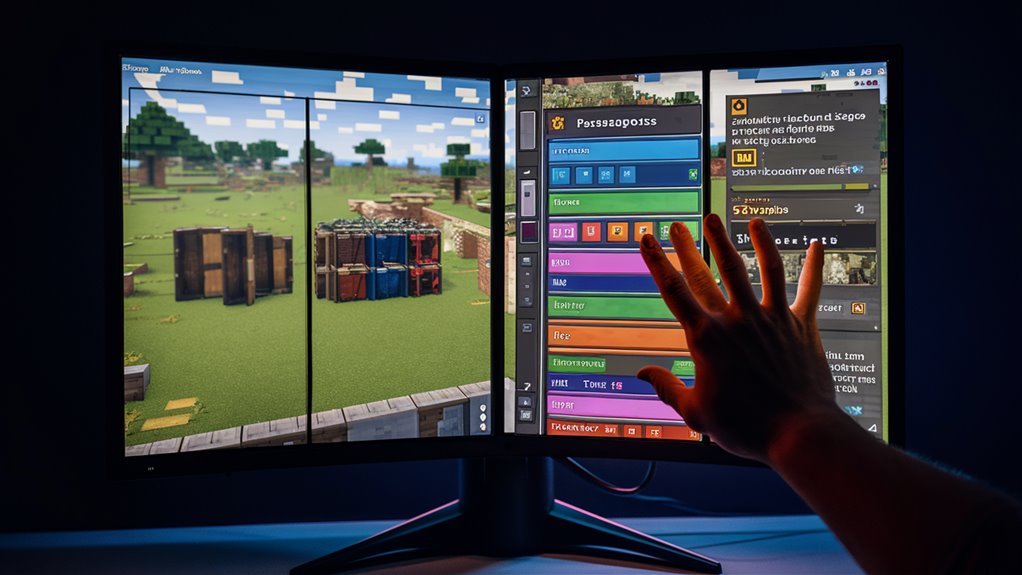
How Can You Effectively Manage In-Game Resources?
Key Takeaways
- Adaptive resource systems respond dynamically to player behavior
- Multiple resource types create strategic depth and meaningful choices
- Personalized resource management enhances player engagement
- Balance between resource availability and scarcity drives gameplay decisions
Resource management in games becomes more engaging when players can customize their approach to handling in-game assets.
Whether managing currency, inventory, character skills, or time, players develop stronger connections to games that respect their individual management styles.
Adaptive Resource Systems
Implementing dynamic resource systems that adjust to player behavior creates personalized experiences.
Players who prefer hoarding resources encounter fewer but more valuable items, while those who spend quickly receive more frequent but lower-value resources.
This responsive approach maintains engagement across different playing styles.
Strategic Resource Types
Multiple resource categories add depth to gameplay decisions:
- Energy points vs. crafting materials
- Health management vs. ammunition conservation
- Time allocation vs. resource gathering
By monitoring how players prioritize these different resources, developers can craft challenges that align with player preferences while maintaining essential tension through strategic scarcity.
Balancing Resource Distribution
The key to effective resource management lies in finding the sweet spot between abundance and scarcity:
- Provide enough resources to maintain player motivation
- Create meaningful choices through limited availability
- Adjust distribution based on player behavior patterns
- Ensure resource decisions impact gameplay progression
Today’s successful games utilize resource management systems that adapt to individual playstyles while maintaining challenging gameplay experiences.
This approach creates deeper player engagement and more satisfying strategic choices.